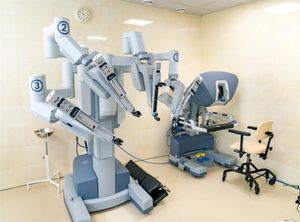
SPONSORED CONTENT -- (StatePoint) For those with lung cancer, understanding treatment options, including what type of surgery might be best for your situation, is important.
Fortunately, the past decade has brought many advances in lung surgery. For example, Robotic thoracic surgery (RAS), also called robotic-assisted thoracic surgery, is a minimally invasive surgery technique used in thoracic procedures, including some lung cancer cases. This technique can be used to remove diseased lung tissue and surrounding lymph nodes.
To learn more about how robotic technology is typically used during lung surgery, the American Lung Association spoke with Dr. Doug Adams, a cardiovascular and thoracic surgeon at TriHealth in Cincinnati. He laid out the general steps he follows with his patients. However, each institution may operate differently. Talk with your surgeon about what to expect.
Before Surgery
Before the procedure, you’ll get information about how to prepare. When you arrive at the hospital, you may go into a room where your information is confirmed, you meet with the anesthesiologist, and lines are started in your body. Lines are tubes usually inserted into the hands that allow the surgery team to monitor vital signs and deliver pain medication.
Next, you’ll be wheeled into the operating room, sedated and placed on your side. You’ll be completely asleep during the procedure. While sleeping, the anesthesiologist places a tube into your airway to collapse the lung not being operated on. This gives the surgeon more space to operate. The lung is reinflated before you wake up.
Getting the Robot Ready
The surgeon finds the right spots on your body for the robot ports, which are like docking stations for the robot. A small incision is made to place each port. The instruments and camera are attached to the robot and docked into the ports, offering real-time control of the robot. Each surgery has basically the same steps, but every body is different. Once the connection is established, the surgeon reviews your anatomy and adjusts the surgical plan accordingly.
Removing Lung Tissue
Your surgeon sits at the console next to you and controls the robotic instruments. First, the small three-dimensional, high-definition camera is placed through one of the ports to provide an inside view of the chest cavity. Then, robotic instruments are placed through the other ports between the ribs.
The surgeon removes lung tissue through one incision. The magnified view and wristed instruments allow for precise, controlled movements without having to make larger incisions to open the chest or spread the ribs. Sometimes the anesthesiologist will inject a liquid called ICG into the lung, which helps the surgeon see more clearly.
If you have cancer, your surgeon may also remove lymph nodes. Often lung cancer will spread to surrounding lymph nodes that imaging doesn’t catch. Removed lymph nodes are examined by the pathology department to help the cancer team determine the lung cancer stage, and next steps.
Post-Surgery
After surgery, a small chest tube is inserted and the ports removed. You’re moved to recovery where staff can monitor fluid and air leaks in your chest. When there is no more fluid or air leaks, it usually means you’ve healed enough to go home, along with post-surgical instructions.
Facing lung surgery? Talk to your doctor about your options, including robotic assisted surgery. Support for this educational initiative is provided by Intuitive.
Photo Credit: (c) Wavebreakmedia / iStock via Getty Images Plus







